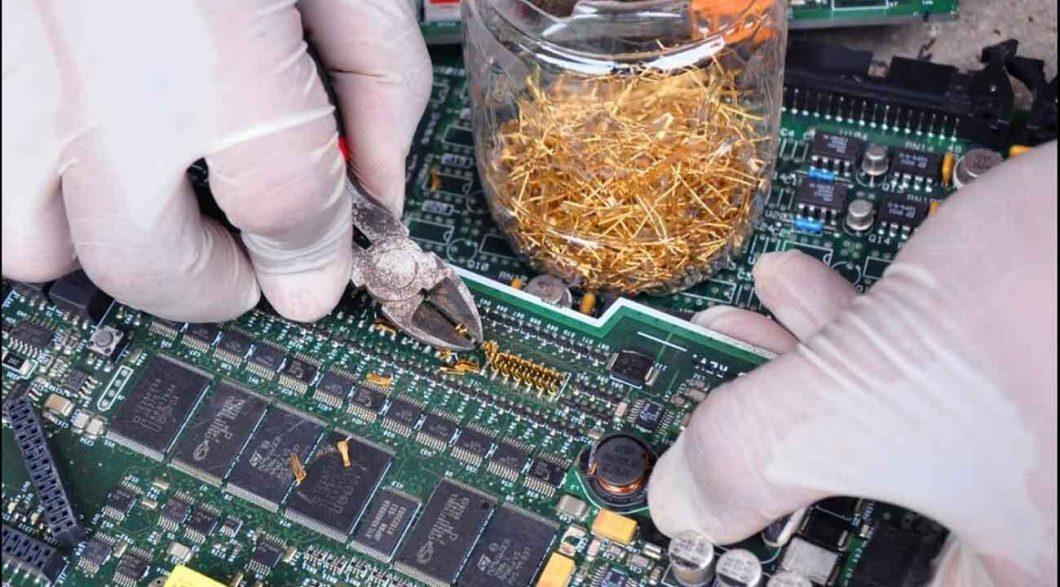
Understanding how to identify precious metals in electronics is only the beginning of the equipment, talent, and experience requirements. Recovering gold from electrical waste is a complex process. Warning: this involves using toxic chemicals and should not be tried at home.
The positive side is that more than ninety percent of e-waste gets repurposed by skilled IT asset disposal organizations. Electronic garbage that cannot be reused is sent to qualified recyclers who are experts at recovering valuable metals without damaging the planet.
Is it Worth it to Recover Gold from Electronics?
Folks have been drawn to gold’s lustrous sheen since the beginning of time.
Conflicts, population movements, colonization of harsh environments like the Yukon, and even slavery have all been sparked by the lure of gold.
Gold’s worth has been recognized worldwide and used for adornment, trade, payment, and ceremonial purposes.
Manufacturers have shifted to using gold as the finishing metal preferred for connections on electronic boards because of gold’s excellent electrical conductivity and resistance to corrosion.
Gold’s price has remained far over $1,500 per ounce. With the current price of gold, an experienced recycler may make more than $10,000 off of a single ton of obsolete computer parts.
Every year, billions of electrical goods throughout the globe become outmoded, unloved, or damaged beyond repair, making gold extraction a lucrative business for recyclers who have mastered the art.
Identifying Precious Metals in Electronics

How do individuals throw away electrical equipment but wouldn’t dream of throwing away cash? Electronics also include other precious metals, including silver, palladium, platinum, and gold.
The vast majority of people are unaware of how to identify precious metals in electronics. The valuable metals may be recycled and put to use in other products. You may receive cash for your old computer by sending it to certain recycling companies. They will gladly take your unwanted machinery and put it to good use somewhere.
A reputable recycler requires knowledge of detecting and recovering valuable metals from gadgets. They must also be aware of how to conduct the extraction process so as to minimize environmental damage.
Electronic devices incorporate precious metals and other substances, some of which are hazardous to people and their surroundings.
Therefore, be wary about who you entrust with your discarded electronics. Look for a certified company that is well recognized as a leader in the technology recycling sector.
Just How Bad is the Electronic Waste Crisis?
Expert recyclers can separate the valuable metals from the rest of the electrical waste. Different metals are used in the construction of various electrical devices. Precious metal content is most significant in the following:
- CPUs.
- Memory.
- Disk drives.
- Motherboards.
- Wires and cables.
- Electrical contacts.
- Wireless communication devices.
Expert recyclers may collect more than gold by sorting through devices for precious metals. In addition to copper, they may mine for various other valuable metals.
Maximum Density of Precious Metals
What kinds of electrical devices have the most gold in them is frequently asked. There is no easy solution since several variables must be considered:
- Age.
- Manufacturer.
- Originating Factory.
- Such as the kind of equipment used.
- Where the electronics were employed.
Because of their stringent quality and reliability standards, aircraft, defense, and telecommunications electronics often use circuit boards with a greater concentration of precious metals.
One million recycled cell phones consist of around:
- Gold worth 75 lb.
- 35 tons of copper.
- 1,600 ounces of gold.
- Palladium weighing 30 pounds.
Electronic Garbage’s Biggest Myths
In addition to plastic, glass, and other substances that have some scrap value, we regularly find silver, platinum, palladium, and gold in our broken or obsolete electronics.
The primary explanation is that electricity is conducted significantly more efficiently through precious metals than alloys.
Electronic gadgets benefit from their corrosion resistance and toughness, for example.
It would help if you had a lot of volume. Each gadget has a limited supply of any one metal.
A significant quantity of devices or component components like RAM is required to make a substantial profit from recycling electronic waste for precious metals.
Sometimes referred to as “urban miners,” these people and businesses collect enough electronic garbage to make a profit.
While the pursuit of gold would certainly be exciting, the market value of IT hardware is typically constrained by processing expenses that are more than the precious metal value.
Conclusion
To begin with, recycling precious metals is preferable to mining since it is cheaper and has fewer adverse effects on our planet. It is believed that 40-800 times as much gold in a single ton of electronic components as in one metric ton of ore.
Second, if discarded with ordinary trash, the heavy metals, batteries, and other elements found in electronics may pollute aquifers in the areas around landfills. That, therefore, poses a danger to the public’s health in the area.
Furthermore, e-waste is threatening to suffocate the globe. About 52.9 million tons of electronic garbage were thrown away worldwide in 2019. From now until 2030, it will increase by 2.2 million tons annually.
The percentage of electronic waste gathered or recycled worldwide in 2019 was just 17.4 percent. From 2014-2019, the number reflects a rise of just 0.4%. The rate at which electronic trash is produced is increasing considerably quicker than the rate at which it is collected and recycled.
In a nutshell, many people are unaware of how to identify precious metals in electronics.

